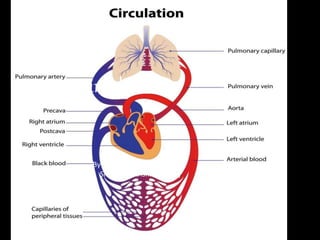
Circulation and Blood
- 2. About Circulation • The systemic circulation provides the functional blood supply to all body tissue. It carries oxygen and nutrients to the cells and picks up carbon dioxide and waste products. • Systemic circulation carries oxygenated blood from the left ventricle, through the arteries, to the capillaries in the tissues of the body. From the tissue capillaries, the deoxygenated blood returns through a system of veins to the right atrium of the heart.
- 3. Characteristics of circulatory system • Circulating fluid Blood Transports useful and waste materials • Pumping device Heart Move through body by muscular contractions of heart • Blood vessels 3 main types of blood vessels: arteries, veins and capillaries • Valves Present in some blood vessels Prevent backflow Ensure blood flows in 1 direction only
- 4. Parts of the Blood Red Blood Cells Red cells, or erythrocytes , are relatively large microscopic cells without nuclei. In this latter trait, they are similar to the primitive prokaryotic cells of bacteria. Red cells normally make up 40-50% of the total blood volume. They transport oxygen from the lungs to all of the living tissues of the body and carry away carbon dioxide. The red cells are produced continuously in our bone marrow from stem cells at a rate of about 2-3 million cells per second. Haemoglobin is the gas transporting protein molecule that makes up 95% of a red cell. Each red cell has about 270,000,000 iron-rich haemoglobin molecules. People who are anaemic generally have a deficiency in red cells, and subsequently feel fatigued due to a shortage of oxygen. The red colour of blood is primarily due to oxygenated red cells.
- 5. Red Blood Cells (erythrocytes) • Biconcave, disc shaped cells without nucleus
- 6. • Transport oxygen from the lungs to all parts of body • Contain a red pigment called hemoglobin which combines with oxygen molecules to form oxyhemoglobin • Carry carbon dioxide from body cells to lungs • RBC are produced in bone marrow • Lifespan: 120 days • When RBC are worn out, they are destroyed in liver and spleen
- 7. • Produced from bone marrow cells • Lifespan of WBC depends on type of WBC. It varies from a few hours to a few months • Play a vital role in body’s defense against diseases – Produce antibodies • WBC can squeeze through walls of blood capillaries into the space among the cells to destroy the bacteria
- 8. White Blood Cells (leucocytes) • WBC are much larger than RBC and they each have a nucleus • Usually irregular in shape, colourless and do not contain hemoglobin
- 9. White Blood Cells • White blood cells (WBCs), also called leukocytes or leucocytes, are the cells of the immune system that are involved in protecting the body against both infectious disease and foreign invaders. All leukocytes are produced and derived from a multipotent cell in the bone marrow known as a hematopoietic stem cell. Leukocytes are found throughout the body, including the blood and lymphatic system. • All white blood cells have nuclei, which distinguishes them from the other blood cells, the enucleated red blood cells (RBCs) and platelets. • The number of leukocytes in the blood is often an indicator of disease, and thus the WBC count is an important subset of the complete blood count. The normal white cell count is usually between 4 and 11 × 109/L. In the US this is usually expressed as 4,000–11,000 white blood cells per microliter of blood.[3] They make up approximately 1% of the total blood volume in a healthy adult,[4] making them substantially less numerous than the RBCs at 40% to 45%. However, this 1% of the blood makes a large difference to health, because immunity depends on it. An increase in the number of leukocytes over the upper limits is called leukocytosis. It is normal when it is part of healthy immune responses, which happen frequently. It is occasionally abnormal, when it is neoplastic or autoimmune in origin. A decrease below the lower limit is called leukopenia. It weakens the immune system.
- 10. Platelets (thrombocytes) • Play an important role in blood clotting
- 11. Platelets • Platelets, also called thrombocytes, are a component of blood whose function (along with the coagulation factors) is to stop bleeding by clumping and clotting blood vessel injuries. Platelets have no cell nucleus: they are fragments of cytoplasm that are derived from the megakaryocytes of the bone marrow, and then enter the circulation. These inactivated platelets are biconvex discoid (lens-shaped) structures, 2–3 µm in greatest diameter. Platelets are found only in mammals, whereas in other animals (e.g. birds, amphibians) thrombocytes circulate as intact mononuclear cells. • On a stained blood smear, platelets appear as dark purple spots, about 20% the diameter of red blood cells. The smear is used to examine platelets for size, shape, qualitative number, and clumping. The ratio of platelets to red blood cells in a healthy adult is 1:10 to 1:20.
- 12. Diseases in the Blood • If you are ill the doctor may ask you to have a blood test. • Some people are born with sickle cell anaemia. • In this disease the blood cell curves into a C shape. • When a person has malaria, the centre of the blood cell bloats creating a dark patch there.